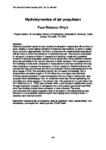Hydrodynamics of jet propulsion
| dc.contributor.author | Wright, Faye | |
| dc.date.accessioned | 2021-07-08T20:18:46Z | |
| dc.date.available | 2021-07-08T20:18:46Z | |
| dc.date.issued | 2021 | |
| dc.identifier.citation |
Wright, F. (2021) ‘Hydrodynamics of jet propulsion’, The Plymouth Student Scientist, 14(1), pp. 452-489. | en_US |
| dc.identifier.uri | http://hdl.handle.net/10026.1/17326 | |
| dc.description.abstract |
Water jet propulsion systems have recently developed in vessels and will continue to grow, leading to scour related problems in harbours and marinas. In order to design scour protection appropriately it is vital to understand the characteristics associated with jet flows to inform the prediction of velocities induced. The study is undertaken in two parts; a literature review of research and existing models and a physical model of a water jet propulsion system from a typical ferry. Data collection occurred along the centreline of the velocity field and in radial transects. The measurements from existing models were compared to measurements and new empirical formulae were developed to assess the accuracy of current equations. Results indicated the velocity field was symmetrical with the most turbulent flows at boundaries and in the latter stages of flow. The centreline velocity did not decay immediately, with a characteristic centreline length of 12.5D where the core region was identified. Existing velocity prediction models underpredict this core region making them less accurate when calculating jet flow. An empirical model was formed calculating the centreline and radial aspects of the velocity field. The general form of centreline flow from Albertson et. al. (1950) was followed, while a new equation radially was formed through regression analysis. In all aspects the model created generated less RMS error than existing models when compared to data collected. The study demonstrated that coastal engineers need to be aware of the characteristics and behaviour of jet propulsion systems rather than relying upon existing models to calculate safe scour protection. | en_US |
| dc.language.iso | en | en_US |
| dc.publisher | University of Plymouth | en_US |
| dc.rights | Attribution 3.0 United States | * |
| dc.rights.uri | http://creativecommons.org/licenses/by/3.0/us/ | * |
| dc.subject | hydrodynamics | en_US |
| dc.subject | jet propulsion | en_US |
| dc.subject | water jet propulsion | en_US |
| dc.subject | scour | en_US |
| dc.subject | coastal design | en_US |
| dc.subject | flow visualisation | en_US |
| dc.subject | submerged flow | en_US |
| dc.subject | velocity profiles | en_US |
| dc.subject | COAST basin | en_US |
| dc.title | Hydrodynamics of jet propulsion | en_US |
| dc.type | Article | en_US |
| plymouth.issue | 1 | |
| plymouth.volume | 14 | |
| plymouth.journal | The Plymouth Student Scientist |



